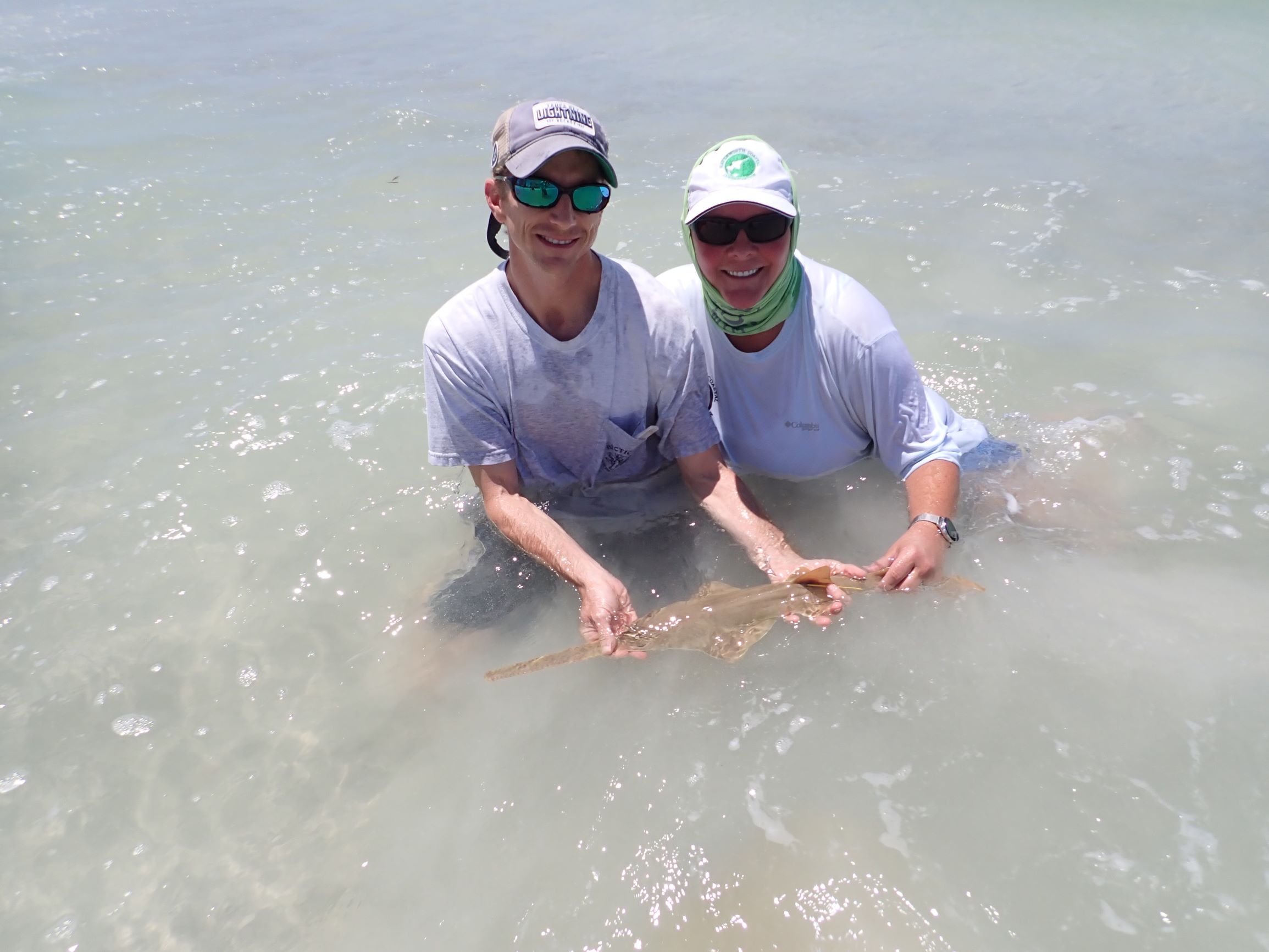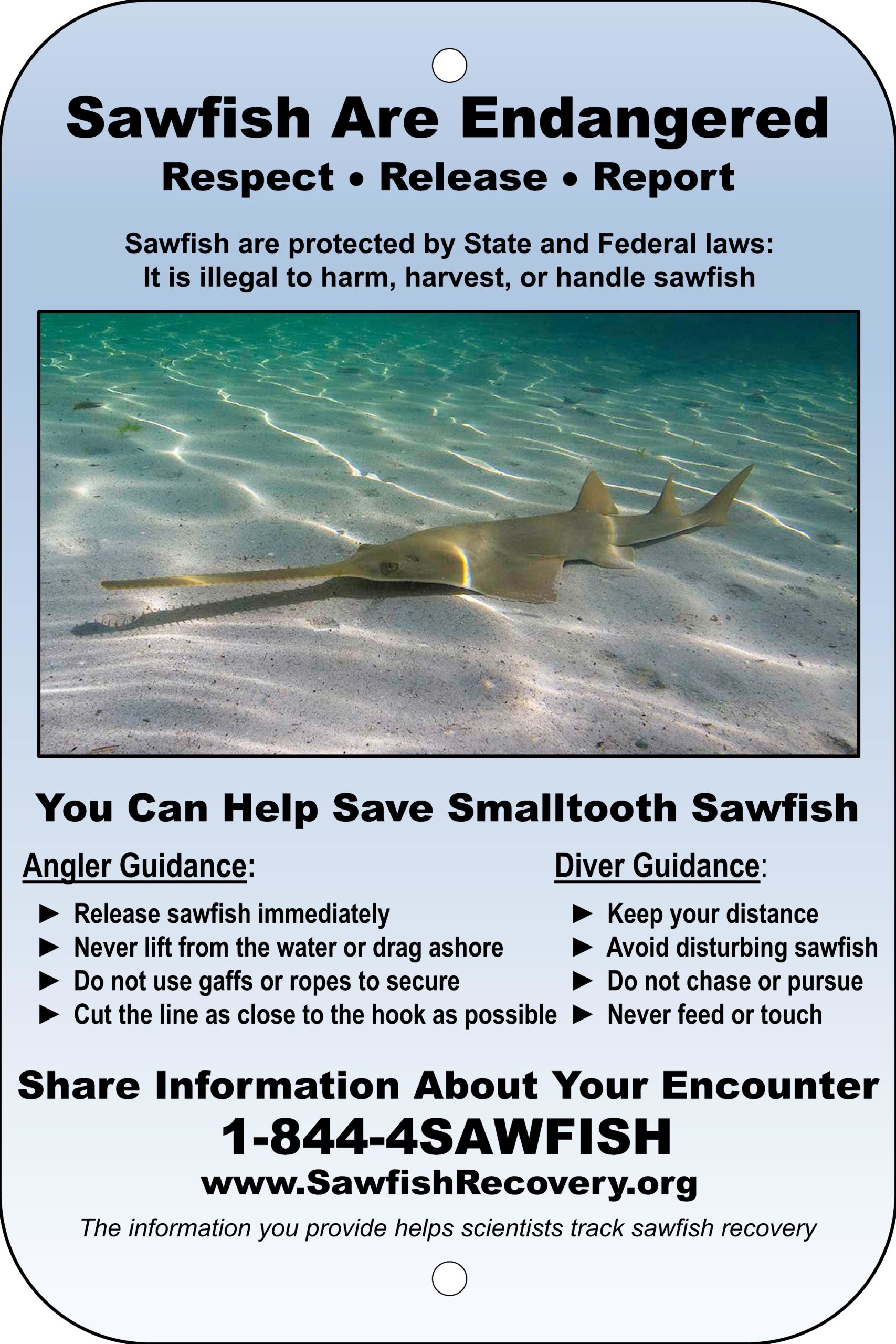
There’s an extremely exciting update to the 2018 Bay Soundings article titled “Endangered Sawfish Slowly Return to Tampa Bay.” That article highlighted the five endangered smalltooth sawfish (an endangered species) reported near Tampa Bay in locations ranging from Anna Maria and the Manatee River to Honeymoon Island. They were mostly young adults or larger juveniles, indicating that the bay was not yet supporting a breeding population of smalltooth sawfish.
Well, now we have newborn sawfish in the area too!
By Tonya Wiley
I saw the email first thing Friday morning: a sawfish had been sighted in the Tampa Bay area. A man walking the beach in Redington Shores the day before had filmed a small sawfish swimming in the shallow surf zone. Thanks to all the outreach and public education that has been done in the area (including posting signs at fishing piers and boat ramps, manning booths at fishing shows and outdoor expos, hanging flyers at tackle stores and bait shops, and writing monthly Sawfish News articles for newspapers and magazines), he knew to share the details of his sawfish observation. He submitted the video and location information to sawfish@myfwc.com.
Since reports of sawfish in the Tampa Bay area are rare, especially small ones, it was critical to respond quickly. I promptly loaded my car with all the gear needed to catch, tag, and release the sawfish if we could find it, although experience suggested this would be a proverbial needle-in-a-haystack scenario. Adam Brame, the NOAA Fisheries sawfish recovery coordinator, and I were at the location within two hours to start our search. We hit the beach and walked in opposite directions to maximize our efforts in searching for the tiny sawfish in the shallow, coastal water.
Within minutes Adam called me – he had found it! I raced to his location and was astonished to see this little 73-centimeter (28-inch) long sawfish in front of me. After easily catching it in a dip net, we quickly collected several measurements. We could tell she was a female from the absence of claspers at the pelvic fins. We tagged her with external and internal identification and tracking tags, collected a small piece of fin tissue (about the size of a pea) for a genetic sample, and released her.

Later that night we celebrated, after all we had finally tagged and released an endangered sawfish in the Tampa Bay area. But that wasn’t the end of the story – there was more good news on the way. A couple of days later, we received another report of a small sawfish in nearly the same location. So my intern Matt Bernanke and I raced back to the beach and repeated the search. Luck was again on our side — we caught and tagged this second sawfish, a 62-centimeter (24-inch) male.
We now have two tagged sawfish in the Tampa Bay area to track and learn from. The transmitters will last about two years. We’ll hopefully get movement data if and when these sawfish pass within range of stationary receivers placed in the Tampa Bay area and beyond. Our receivers are a small part of a vast network of these listening stations in the southeastern United States through the iTAG and FACT programs.
The fin clip samples will be processed by our sawfish geneticist, Kevin Feldheim at The Field Museum, to determine if the two sawfish are siblings and to provide additional information about their relatedness to other sawfish in our U.S. research database.
To find sawfish pups north of their typical nursery areas (Charlotte Harbor to Everglades National Park) was remarkably interesting and exciting, but it also raised several scientific questions. Why were these sawfish born in the unprotected, high-energy waters of a Gulf of Mexico beach instead of the safe, calm, mangrove-lined shorelines of Tampa Bay backwater areas?
Although the two sawfish were the size we know them to be when born, did the mother intend to drop her young there, or did something cause her to give birth early? Did she drop her entire litter of pups or only a few on her way to a more suitable nursery habitat? Could this be a sign that smalltooth sawfish are expanding northward and are reestablishing in Tampa Bay? All are exciting questions that additional research will help us answer.
 Will we get more reports from the public of sawfish they see or catch? This story highlights the importance of citizen science and prompt teamwork communication, but citizen science only works when successful outreach campaigns educate the public. In this case, years of outreach in the Tampa Bay region paid off, resulting in multiple public reports of sawfish sightings. If you ever catch or see a sawfish anywhere in the United States, please share the information by visiting www.SawfishRecovery.org, calling 1-844-4SAWFISH, emailing sawfish@myfwc.com, or submitting the information through the FWC Reporter app. Your encounter report might lead us to tag the next endangered smalltooth sawfish in the Tampa Bay area!
Will we get more reports from the public of sawfish they see or catch? This story highlights the importance of citizen science and prompt teamwork communication, but citizen science only works when successful outreach campaigns educate the public. In this case, years of outreach in the Tampa Bay region paid off, resulting in multiple public reports of sawfish sightings. If you ever catch or see a sawfish anywhere in the United States, please share the information by visiting www.SawfishRecovery.org, calling 1-844-4SAWFISH, emailing sawfish@myfwc.com, or submitting the information through the FWC Reporter app. Your encounter report might lead us to tag the next endangered smalltooth sawfish in the Tampa Bay area!
Tonya Wiley is leading the project to study the sawfish of Tampa Bay with support from the Save Our Seas Foundation. A fisheries biologist who conducted research on smalltooth sawfish for Mote Marine Laboratory, she later established Havenworth Coastal Conservation in Palmetto to protect imperiled marine species through research, outreach and education. She is a member of the National Marine Fisheries Service’s Smalltooth Recovery Implementation team, a multi-institutional panel of experts working to protect the remaining sawfish population in the U.S. and prevent the species from going extinct. You can follow Havenworth Coastal Conservation on Facebook and Twitter for updates from the field. She also is available for presentations on sawfish to groups and organizations. Tax-deductible donations to help Havenworth continue sawfish research in Tampa Bay can be made at https://havenworth.wedid.it, or you can reach her at Tonya@havenworth.org or 941-201-2685.
All research activities were performed under the authority and guidelines of NMFS ESA permit #21857.
Attachments:
4 photographs provided, captions and credits below
Tonya Wiley (right) and Adam Brame (the NOAA Fisheries U.S. sawfish recovery coordinator) with the first sawfish tagged in Tampa Bay, a newborn located in Redington Shores in April 2021. All research activities were performed under the authority and guidelines of NMFS ESA permit #21857. Credit Tonya Wiley.
Tonya Wiley prepares to release a tagged sawfish along the beach in Tampa Bay in May 2021. All research activities were performed under the authority and guidelines of NMFS ESA permit #21857. Credit Matthew Bernanke.
The second tagged sawfish about to be released in Redington Shores in May 2021. All research activities were performed under the authority and guidelines of NMFS ESA permit #21857. Credit Matthew Bernanke.
Sawfish handling and release, viewing, and reporting information posted at marinas, boat ramps, fishing piers, bait and tackle shops, and dive centers around Tampa Bay.
